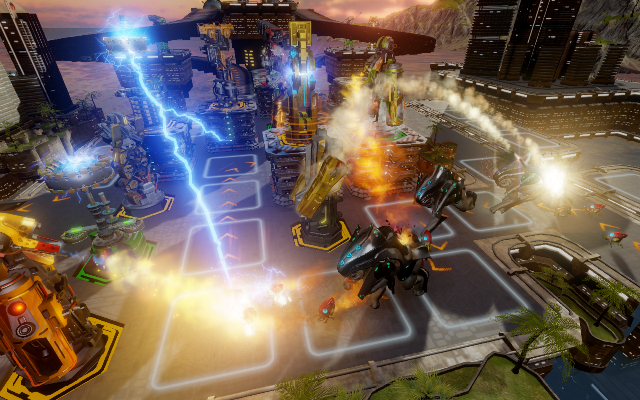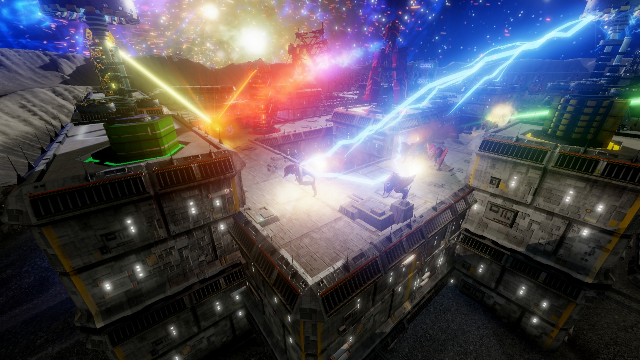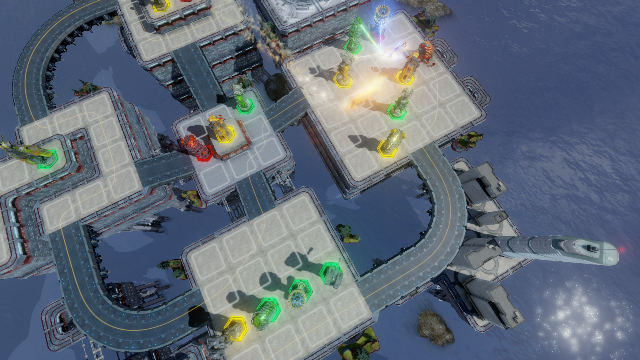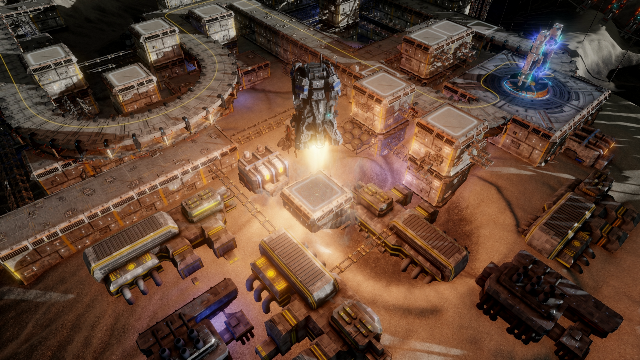Defense Grid 2 preview: Break up for the kids
The crawlers keep crawling, and the drip keeps dripping in Defense Grid 2.
Hidden Path Entertainment’s sequel to its 2008 tower defense game features a new resource and score system known as “the drip,” and it works exactly as planned: it makes games winnable for greenhorns while keeping aces chasing after higher scores that are achieved by killing crawling aliens with all manner of haste.
Never having played Defense Grid: The Awakening, I wasn’t sure exactly what to expect out of its follow-up when I picked up the controller at PAX East. From the outset, the player is confronted with a multitude of options for defending the base from unwanted pests and a cluster of information tracking your progress in this endeavor. The amount of data and options on the screen paired with the constant march of baddies out of their gate, towards my tower and back again with poached cores in tow could have been overwhelming. It could have been, but it wasn’t. Hidden Path Entertainment saw to that with its streamlined presentation of data, tower building options and drip-drop of resources. Everything was pleasantly intuitive and easily manageable.
Sometimes, divorce is the answer
Being intuitive for beginners while remaining fun and challenging for experts is exactly what Hidden Path was aiming for with its sequel. Though it’s impossible to report on the latter, I can tell you that the studio pulled off the former with aplomb. The drip, which Polygon first reported on here, allows for resources to constantly accumulate as a line graph tracks your score in the upper right corner of the screen. Regardless of what your score is, your resource distribution rate remains the same. The rate of the drip in the PAX build allowed me to erect large quantities of a mixture of the six tower types present (cannon, missile, laser, gun, inferno and tesla) and upgrade many of them to carry more firepower.
Executive Producer Jeff Pobst explains that his team separated score from resource distribution in Defense Grid 2 in order to avoid the “negative feedback loop” that many players got stuck in due to poor decision making in the first game. As Pobst describes it, novices would waste too many of their resources early on building the wrong types of towers or placing towers in poor positions. This would leave them unable to repel enemies and unable to gather enough resources to compensate for their mistakes. Meanwhile, top players would dominate early on and find themselves with an embarrassment of riches, making victory too easily achieved.
“We felt that that was kind of a poor experience for both,” says Pobst. “Resources help you make core decisions; if you have way too many of them it’s kind of boring. If you don’t have enough it’s kind of frustrating. So we’re trying to bring that in to make it a good experience for everybody, but we still want to reward that same behavior before that — if you’re a good player — you’re going to get a higher score if you hold onto resources longer and gain interest on them, if you keep the cores in the core housing, if you destroy the alien waves sooner. If you do all of those things, you’re going to get a higher score faster.”
Reaching the perfect drip rate hasn’t been easy, which is why Hidden Path is still working on it. According to Pobst, his team is “70 to 80 percent” of the way to hitting the sweet spot. In the demo, it always felt like there were more resources than necessary to wipe out all of the aliens before they procured the entirety of my base’s power cores. Of course, the fact that they did get their grubby little hands on my base is proof that a superior player could have better managed his resources and attained a higher score.
Making smart decisions quickly
While resources are being distributed and your score is being tracked by the new systems, the gameplay clips right along similarly to most tower defense titles. At the start of each level, enemies are free to plot the best route to your base with a Google Maps-like efficiency, and you’re tasked with disrupting them. I began both of my play sessions by purchasing affordable gun towers to distribute a moderate amount of ranged damage and mixing in some inferno towers for area-of-effect attacks. Adding laser towers to the mix helped greet the crawling aliens with persistent suffering. In addition to inflicting as much damage as possible on enemies, players will want to blockade the aliens’ direct route to their base by building towers on squares in their path. This tactic forces the aliens to pivot around your towers, making them take more steps en route to your base and absorbing more damage while doing so.
Defense Grid 2 conveniently displays how the enemies’ route will be affected when you’re plotting out locations for new towers. It then takes things a step further by allowing you to pull up heat maps displaying where your towers have been damaging crawlers the most, helping to optimize your decisions about what towers to upgrade and what squares to construct new towers on. The game instills an appropriate amount of tension to ensure you don’t spend too long agonizing over every decision, though. Resources are always flowing in, your score is being tracked in real time and — aside from brief breaks between waves — aliens constantly proceed towards their goal.
“So all of those same mechanics are there, but they’ve just been split into a score side and a resource side,” says Pobst of how his team changed the way Defense Grid 2 matches play out without actually changing the basic strategy of how you play matches. “The thing is, as we’re messing with the resource side, we’re inadvertently…dealing with the pace of decision making. And one of the things that really defines a game — whether it’s a shooter, a strategy game, a tower defense game — is the pace of the decision making. And so what we had realized [a few months ago] is we had balanced resources versus score properly, but in doing so had harmed the pace of decision making in the game.”
Since coming to that realization, Hidden Path has been working on getting the game’s pace right without disrupting the balance of the score tracking and resource distribution. The studio seems to be on the right track: while playing, I felt pressured to quickly make choices, but not overly so. I didn’t want to waste too much time stressing over whether to build a new canon or missile tower to provide massive ranged firepower or increase the output of an inferno tower to harm enemies more as they slowly made their way around corners. At the same time, taking a moment to think through a decision never felt like it would result in the crawlers getting the time they needed to change the tide of battle.
Feeling good
The game’s multiplayer mode wasn’t on display at PAX East, but I asked if extra care had to be put into how the drip worked when a second player gets in on the action. Pobst explained that that wasn’t the case.
“Now there is some balancing we still need to do on that,” he said. “If you have a very large map, being near the core housing is the smart place to be doing that, because the aliens are closer to the core housing. So what you’ll probably see in the final version is a difference in strength of alien based on distance from core housing. So you as a player can decide, ‘Well, I’m going to kill the aliens far away from the core housing, and they’ll show up even stronger on my opponent’s side, or I can have them really close to the core house, but they’re a little weaker. And then you can be making that kind of choice.”
Once Hidden Path gets what it calls the “emotional feel” of the drip perfected, it will be tracking how players make decisions and how those decisions affect gameplay in a public Steam beta later this year. Doing so will give the studio the ability to make sure hard data supports what feelings intimate.
Even in its unfinished state, Defense Grid 2‘s new resource and score systems allow most anyone to enjoy the thrill of victory. In between my two play sessions, I witness undeniable proof of this.
A father and son walk up to the demo station. The boy, appearing no more than seven or eight years old, picks up the controller and begins the struggle to protect his cores. When dad tries to help, his son brushes him off, saying he knows what he’s doing. He achieves victory several minutes later, substantiating his claim of ability — and Hidden Path’s claim of approachability.




